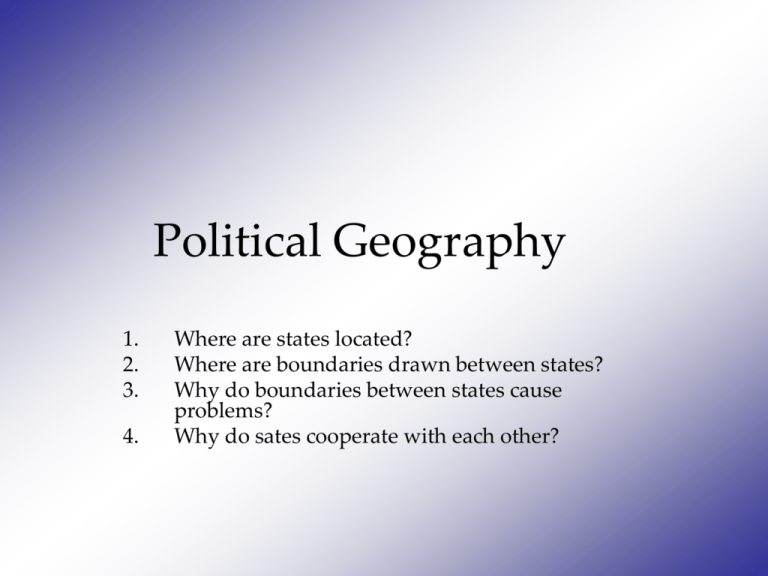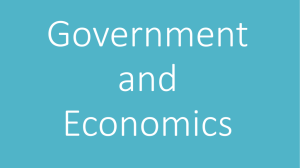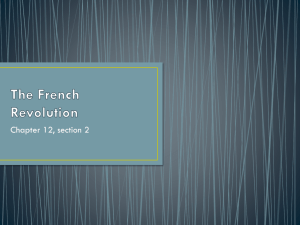Political Geography - Murrieta Valley Unified School District
advertisement

Political Geography 1. 2. 3. 4. Where are states located? Where are boundaries drawn between states? Why do boundaries between states cause problems? Why do sates cooperate with each other? POLITICAL GEOGRAPHY Interaction of politics and place • The study of the interaction of geographical area and political process • It is the formal study of territoriality. • Covers forms of government, borders, treaties, trading blocs, conflicts and war. STATE • A politically organized territory • Administered by a sovereign government • Recognized by a significant portion of the international community. A state must also contain: – a permanent resident population – an organized economy I. Where are states Located? A. Problems of defining States 1. State- An area organized into a political unit by a sovereign government. Occupies a defined area on the earths surface with a permanent population 2. Sovereignty- A states independence of internal affairs from other states 3. Antarctica is the only land mass that does not belong to any state. Treaties of 1959 and 1991 define this Some countries claim portions but the UN refuses to acknowledge claim Australia, Norway, France, Chile, U.K., New Zealand 4. Korea- occupied by Japan until after WWII then divided into two sovereign countries North Korea (Communist) and South Korea (Dictatorship/ Democracy) » North Korea ( Democratic Peoples Republic of Korea) » South Korea ( Republic of Korea) In 1950 the North will invade the South and start a three year war- Korean War » The US backed the South (37,000 casualties) » The Soviets backed the North Truce was drawn in 1953 at the 38th Parallel » Armistice still stands today- actively at war » DMZ- The most militarized zone in Korea 5. China and Taiwan- after the communist take over of China the Nationalist fled » The nationalist claim to be the rulers of China but will take Taiwan for now » Since then China has claimed Taiwan but the people of Taiwan still claim sovereignty 6. Africa- Sahrawi Arab Democratic Republic claims the territory of the western Sahara » Morocco claims their own sovereignty and built a wall around its city » Cease fire was administered by the UN in 1991; Spain now controls two cities in Morocco United Nations Member States (192) The United Nations System is based on five active principal organs UN General Assembly UN Security Council UN Economic and Social Council UN Secretariat International Court of Justice Non-member States Taiwan (China) Vatican City Western Sahara (territory of Morocco) Palestinian Territories Tibet (China) Enlargement of Soviet bloc after World War II Berlin Wall, 1961-89 Changes in Europe, 1990-93 B. Varying Size of States 1. Largest – Russia – 6.6 million square miles 2. Other states more than 2 million a. Canada, US, China, Brazil, and Australia 3. Monaco- .6 square miles 4. Microstates – states with very small land areas C. Development of the State Concept 1. Ancient and Medieval States a. Ancient Fertile Crescent b. First states were known as City-States 2. Early European States a. Roman Empire b. Collapsed in 5th Century NATION - STATE • A country whose population possesses a substantial degree of cultural homogeneity and unity. Classic Example of a Nation-State: Japan 3. Colonialism- effort of one country to implement settlements to impose political, economic, an a cultural agenda on another territory » » » » 3 reasonsMissionaries trying to impose Christianity Raw materials and other resources Increase the prestige of their country ( more territories) 4. Colony- territory that is legally tied to a sovereign state rather then being completely independent a. b. c. d. European states Imperialism Few remaining colonies Least populated African colonies Koreans Imperialism: Kim So Wol • When seeing me sickens you and you walk out I'll send you off without a word, no fuss. • Yongbyon's mount Yaksan's azaleas by the armful I'll scatter in your path. • With parting steps on those strewn flowers treading lightly, go on, leave. • When seeing me sickens you and you walk out why, I'd rather die than weep one tear. Decolonization, 1940s-1990s How Americans View the World? East versus West: View of Communist “Red Bloc” during Cold War Lumping failed to recognize differences among Communists, or local causes of conflict II. Where are boundaries drawn? Why do boundaries cause problems? A. Boundary- invisible marking the extent of a states territory 1. 2 typesa. Physical- Mountains, Deserts, water -All strategically important -Oceans are problem because the extent that country owns; 1983- established ruling 12 nautical miles out from land and fishing rights 200 miles b. Cultural Boundaries- Geometricmathematical lines drawn on a map -Religious, Language (often found in Europe) -Implemented lines- UN nations- Green Line in Cyprus -Relic Boundaries- Hadrian's wall and the Great Wall Forms of Government Monarchies: Republics: Constitutional Monarchy Democracy Traditional Monarchy Absolute Monarchy Restricted Democratic Practice Authoritarian Regime Totalitarian Regime Non-Sovereign: Protectorate Colonial Dependency Empire Source: Matthew White, 2003. http://users.erols.com/mwhite28/othergov.htm Adapted from FreedomHouse.org Monarchies: Republics: Constitutional Monarchy Democracy Traditional Monarchy Absolute Monarchy Restricted Democratic Practice Authoritarian Regime Totalitarian Regime Non-Sovereign: Protectorate Colonial Dependency Empire Source: Matthew White, 2003. http://users.erols.com/mwhite28/othergov.htm Adapted from FreedomHouse.org Monarchies: Republics: Constitutional Monarchy Democracy Traditional Monarchy Absolute Monarchy Restricted Democratic Practice Authoritarian Regime Totalitarian Regime Non-Sovereign: Protectorate Colonial Dependency Empire Source: Matthew White, 2003. http://users.erols.com/mwhite28/othergov.htm Adapted from FreedomHouse.org U.S.Canada boundary AlbertaMontana U.S.Mexico boundary Calexico, CaliforniaMexicali, Mexico Iguazu Falls, Argentina / Paraguay MexicoGuatemala Border Region B. This leads to five shapes of states1. Compact States- distance from the center to the boundary is short 2. Prorupted State- Compact state with large projecting extensions, ex Congo 3. Elongated- Long and narrow- ex. Chili 4. Fragmented- Several discontinued pieces- Ex U.S. 5. Perforated State- Completely surrounds another state- ex South Africa Compact Fragmented Prorupted Perforated State Elongated C. Other types 1. Landlocked- no direct outlet to the ocean- ex most of Africa 2. Frontier- zone where state exercises complete control 3. Unitary State- most of the power is in the hands of the central government 4. Federal State- allocates large power to units in local govt within the country • The trend recently is allocates more power to the central government then to the independent territories The Geography of Representation D. Electoral geography 1. Redistricting 2. Gerrymandering (practice of drawing boundaries of legislative districts so as to unfairly favor one political party over another). ELECTORAL GEOGRAPHY Political Geography of Elections Variation of voting districts and voting patterns VOTER TURN-OUT All elections since 1945-1998 Country ELECTORAL GEOGRAPHY vote/VAP % 1 Italy 92.5 2 Cambodia 90.5 3 Seychelles 96.1 4 Iceland 89.5 36 Romania 77.2 37 Spain 75 Luxembourg 64.1 76 Nepal 63.7 95 Malaysia 96 Zimbabwe 58.8 97 Jamaica 58.5 106 Honduras 55.3 107 Russia 108 Panama 53.4 109 Poland 52.3 110 Uganda 50.6 114 USA 48.3 115 Mexico 48.1 116 Peru Source: International Institute for Democracy and Electoral Assistance, 2005 77 59 55 48 • Gerrymandering- the process of redrawing lines in order to benefit the party in power Wasted vote – spreads opposition supporters across many districts but in the minority Excess vote – concentrates opposition supporters into a few districts Stacked vote – links distant areas of likeminded voters through oddly shaped boundaries “Gerrymandering” Redistricting for partisan purposes Fig.9.p332 U.S. congressional delegation redistricting Reapportionment : allocating seats to a geographic area (normally done after every census) Tom Delay’s District in Texas After Texas Republicans won a majority in 2002, they enacted redistricting legislation to protect their wins. Congressional reapportionment 1860 Presidential Vote Led to Southern secession, Civil War 1996 Presidential Vote Davis (D) Simon (R) Camejo (G) Copeland (L) 48% 42% 5% 2% 2004 Presidential Vote 2004 Presidential Vote Centripetal Forces • • • • Nationalism Unifying Institutions Organization & Administration Transportation & Communication Fig.9.19 • Boundary Disputes: – Territorial (definitional) • Defined political boundaries – Functional (operational) • National security or help through boundaries – Positional (locational) • Dispute among the boundary being written up – Chile vs Argentina- Based their border on water sheds problems with new technology – Resources (allocational) • Resources Centrifugal Forces • Organized religion • Nationalism (part-nation state/stateless nations) • Regionalism (French Canadians) • Devolution (Great Britain) • Irredentism • Devoluton (area in country that desires greater autonomy or independence. Yugoslavia; Great Britain (Scotland, Wales, Northern Ireland) Basque Fig.9.21 Political Conflict • Northern Ireland • Middle East (Palestine) • Sudan Northern Ireland • Colony: 1921 • Unionists (Protestants) • Nationalists (Catholics) • Sinn Fein (political arm of IRA) • IRA Good Friday Agreement (1998) Israeli/Palestinian • • • • • Roots in Diaspora 70 a.d. Zionist movement 1880s Created in 1948; immediately attacked 1964: founding of PLO Both agree to a two-state solution What They Have to Agree Upon • The status and future of the West Bank, Gaza Strip and East Jerusalem, which Israel considers in dispute and Palestinians as well as most of the international community consider occupied • Israeli security from attacks against Israeli targets, which Israel considers acts of terrorism and Palestinians as legitimate resistance against an illegal occupying force • Palestinian security from Israeli military attacks. • The nature of a future Palestinian state. • The fate of the Palestinian refugees. • The settlement policies of Israel, and the ultimate fate of settlements. Sudan • Black Arabs in the North/non-Arab blacks in the south. South Muslim, Christian/animistic. North Muslim. • Government controlled by Muslim Arabs. • South: more resources. Water, better land, now oil. Farmers • North: pastoralists. Went south looking for land and water. • Long civil war. Peace agreement in 2003. Except in Darfur. Rebels (black non-Arab) felt government discriminating against them. • Conflict begins in 2003. • Gov’t supporting (although they deny it) Janjaweed. Force children from south to fight against their own families and neighbors. • UN resolutions past, but little help. Sanctions • African Union sent in troops. UN has some “observers”. Encouraging African Union to send in more “peacekeepers”. III. Why do states cooperate with each other? A. Political and Military Cooperation 1. Balance of Power- A condition of equal strength betwixt opposing alliances 2. Political reasons- the most important super national organization is the UN (1945) over 190 countries belong. • Though the power is limited it is a step towards world peace; power of military and political force • Should the UN be able to interfere with other countries? S. Korea Kim Jung Ill Cooperation Among States 3. Supranationalism: Three or more countries join forces to achieve a common goal • • • • European Union (economic) NAFTA (economic) NATO (military) Warsaw Pact (Military) Fig.9.22 Fig.9.26 Fig.9.27 United Nations Member States (192) The United Nations System is based on five active principal organs UN General Assembly UN Security Council UN Economic and Social Council UN Secretariat International Court of Justice Non-member States Taiwan (China) Vatican City Western Sahara (territory of Morocco) Palestinian Territories Tibet (China) Sample United Nations Organizations UNDP - United Nations Development Programme UNIFEM - United Nations Development Fund for Women UNV - United Nations Volunteers UNEP - United Nations Environment Programme UNFPA - United Nations Fund for Population Activities UNHCR - Office of the United Nations High Commissioner for Refugees UN-HABITAT - United Nations Human Settlements Programme (UNHABITAT) UNICEF - United Nations Children's Fund 3. Other Military Organizations• OAS- Organization of American States- 35 western hemisphere states • OAU- Organization of African Unity- all African States • Common wealth of Nation- the UK and 53 former colonies • OSCE – Organization on Security and Cooperation in Europe 4. Economic Purposes• European Union- the EURO help develop western Europe into the most viable market in the world • Germany dominates the power but has stringent guidelines for the Baltic states European Union Began as European Economic Community (EEC), 1957. Stronger in 1994 10 new members joined, 2004 Turkey and Romania want to join but have faced resistance. International Cooperation Treaties and Trading Blocs •Economic Treaties and Free Trade Agreements •Military Alliances •Supranational Agreements Map of NATO Countries Trading Blocs OPEC The Organization of the Petroleum Exporting Countries (OPEC) is a large group of countries[1][2] made up of Algeria, Angola, Indonesia, Iran, Iraq, Kuwait, Libya, Nigeria, Qatar, Saudi Arabia, the United Arab Emirates, Venezuela, and Ecuador (which rejoined OPEC in November 2007) IV. Terrorism in the 21st century A. Quran verse; whyIslam.org – Al-Quran 6:151 • "take not life, which God hath made sacred, except by way of justice and law: thus doth He command you, that ye may learn Wisdom." • During a war, the Prophet saw the corpse of a woman lying on the ground and observed: "She was not fighting. How then she came to be killed?" Thus non-combatants are guaranteed security of life even if their state is at war with an Islamic state. • “Let there be no compulsion in religion: Truth stands out clear from Error: whoever rejects evil and believes in God hath grasped the most trustworthy hand-hold, that never breaks. And God heareth and knoweth all things.” [Al-Qur’an 2:256] Terrorism- systematic use of violence by a group in order to get demands from a particular government • Radical fundamentalist, Christians, Muslims • Formation of groups like the Al-Qaeda increased world wide terrorism B. Al-Qaeda- founded by Osama binLaden used several million dollars from his fathers billion dollar fortune and U.S. support in order form this group – Formed in 1990- United jihad fighter against U.S. ‘the great Satan” • U.S. support of the Saudi royal family and Israel's Jewish state – Apexes September 11th 2001 » Where were you? C. State support of terrorism – Sanctuary granted for terrorist- Taliban harboring Al Qaeda in Afghanistan – Supplying weapons, money and intelligence – Using terrorist to attack enemies- Libyan government hired terrorist to bomb a Berlin club where Americans frequented D. The Afghanistan and the Iraq war were both attempts to stop terrorism; we occupy both countries actively today – EC- “The Green Zone” “United 93” E. Other countries that actively support terrorism – – – – – Yemen Sudan Syria North Korea Iran • Why is there an influx of young terrorist in udc? Geopolitical Theory • • • • Ratzel Mackinder Spykman Domino • Rubenstein, James- Cultural Landscape; An Introduction to Human Geography • http://www.glendale.edu/geo/reed/cultural/ cultural_lectures.htm • http://www.quia.com/pages/mrsbellaphg.ht ml • Google






